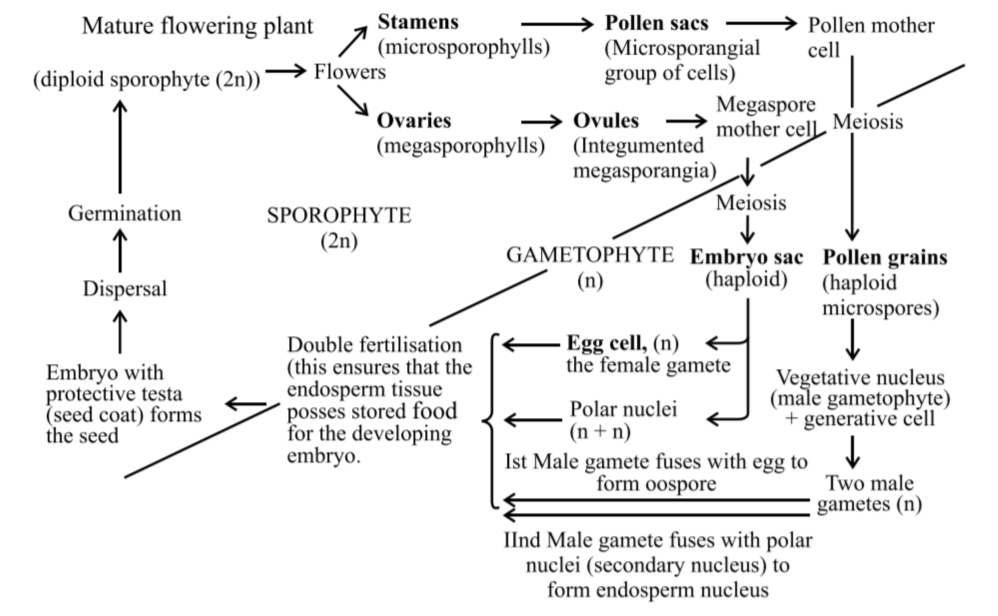Angiosperms are most dominant and most evolved plants on this earth, appeared about 130 million years ago in Jurassic (dicot plant) and cretaceous (monocot plants) period of the Mesozoic era. Tertiary period of Cenozoic era is called as Age of angiosperms.
Angiosperms are found in every habitat. They constitute more than 50% of the total plants on this earth.
Angiosperms are seed bearing, flowering vascular plants in which seeds are enclosed in fruits. The term angiosperm means ‘enclosed seeds’ as seeds (ovules) are found enclosed in the ovary wall.
Instead of a cone, angiosperms bear flowers. The flower is the most characteristic structure of the angiosperms.
The flower is defined as a modified shoot meant essentially for the reproduction of the plant.
The flower usually develops as a branch from a bud, growing in the axil of a small leaflike structure known as bract. A stalk called pedicel supports the flower in the axil of the bract. The upper swollen end of the pedicel called receptacle or thalamus bears all the floral parts.
A typical angiospermic flower consists of 4 whorls, viz., calyx, corolla, androecium and gynoecium. Both calyx and corolla are known as accessory or helping whorls. The androecium and gynoecium are called reproductive or essential whorls.
Androecium (stamen) is microsporophyll and gynoecium (carpel) is megasporophyll. Megasporophyll is differentiated into ovary, style and stigma.
Angiosperms lack both archegonia and antheridia. The archegonium is replaced by gynoecium (pistil) and antheridium by pollen tube.
Flowers are adapted for various modes of pollination by birds, air, water, insects, etc.
The outermost axillary whorl of the flower is the calyx, represented by the sepals.
Corolla is the second whorl of flower present inner to calyx and is composed of petals. The bright color of the petals combined with the scent of essential oils present in some flowers makes the flower highly attractive to insects which act as agents for pollination.
The angiosperms are an exceptionally large group of plants occurring in wide range of habitats. They range in size from tiny, almost microscopic Wolffi too tall trees of Eucalyptus (over 100 metres). They provide food, fodder, fuel, medicines and several other commercially important products.
The male sex organs in a flower is the stamen. Each stamen consists of a slender filament with an anther at the tip. The anthers after meiosis, produce pollen grains.
The female sex organs in a flower are the pistil or the carpel. Pistil consists of an ovary enclosing one to many ovules. Within ovules are present highly reduced female gametophytes termed embryosacs. The embryo-sac formation is preceded by meiosis. Hence, each of the cells of an embryo-sac is haploid. Each embryo-sac has a three-celled egg apparatus – one egg cell and two synergids, three antipodal cells and two polar nuclei. The polar nuclei eventually fuse to produce a diploid secondary nucleus.
Pollen grain shed at 2-3 celled stage after dispersal from the anthers is carried by wind or various other agencies to the stigma of a pistil. This is termed as pollination.
The pollen grains germinate on the stigma and the resulting pollen tubes grow through the tissues of stigma and style and reach the ovule.
The pollen tubes enter the embryo-sac where two male gametes are discharged.
One of the male gametes fuses with the egg cell to form a zygote (syngamy).
The other male gamete fuses with the diploid secondary nucleus to produce the triploid primary endosperm nucleus (PEN) known as triple fusion.
Because of the involvement of two fusions, this event is termed as double fertilisation, and event unique to angiosperms.
The zygote develops into an embryo (with one or two cotyledons) and the PEN develops into endosperm which provides nourishment to the developing embryo.
The synergids and antipodals degenerate after fertilisation.
During these events, the ovules develop into seeds and the ovaries develop into a fruit.
A fruit is a ripened ovary. The ovary wall enlarges due to cell division and cell enlargement and is termed the pericarp. In fl eshy fruits, the pericarp is often differentiated into epicarp,
mesocarp and endocarp.
A true fruit is one which develops directly from an ovary. Sometimes other parts of the flower such as thalamus, sepals, etc. become a part of the fruit. Such fruits are termed false, spurious or pseudocarp, as in cashew-nut, apple, strawberry, etc.
They are divided into two classes:
the dicotyledons and the monocotyledons.
The dicotyledons are characterised by having two cotyledons in their seeds while the monocotyledons have only one.
Characteristics features of dicot & monocot
The dicotyledons are characterised by seeds having two cotyledons, reticulate venations in leaves, and tetramerous or pentamerous flowers i.e., having four or five members in each floral whorls, concentric arrangement of tissues in stem, open, conjoint and collateral vascular bundles in the stem, secondary growth present, less than 8 radial vascular bundles in the root, reticulate venation in leaves (exception Calophyllum, Corymbium), tetramerous or pentamerous flowers e.g., Eucalyptus, Mustard, Sunflower, Rose, Cotton, Apple. Number of dicot species is 200,000.
The monocotyledons, on the other hand, are characterised by single cotyledonous seeds, parallel venation in leaves, and trimerous flowers having three members in each floral whorls, scattered, closed, collateral and conjoint vascular bundles in stem, vascular bundles with a bundle sheath, more than 8 radial vascular bundles in the root, parallel venation in leaves (exception Colocasia, Alocasia, Smilax) e.g., grasses, cereals, orchids, lilies, palms, banana, sugarcane, bamboos. Some 50,000 species.








Leave a Reply
You must be logged in to post a comment.